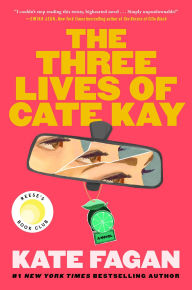My Life-Long Dream: A Guest Post by Kate Fagan
A tale about identity, coming-of-age, friendship and love, The Three Lives of Cate Kay is a dazzling, big-hearted journey. Read on for Kate Fagan’s exclusive essay on how she tricked her brain into finding her character’s voice and what made her want to write her debut novel.
The Three Lives of Cate Kay (Reese's Book Club)
The Three Lives of Cate Kay (Reese's Book Club)
By Kate Fagan
In Stock Online
Hardcover
$22.99
$27.99
The Seven Husbands of Evelyn Hugo meets First Lie Wins in this electric, voice-driven debut novel about an elusive bestselling author who decides to finally confess her true identity after years of hiding from her past.
The Seven Husbands of Evelyn Hugo meets First Lie Wins in this electric, voice-driven debut novel about an elusive bestselling author who decides to finally confess her true identity after years of hiding from her past.
Right now, like most writers, I have in my metaphorical desk drawer four full novels and an additional half dozen manuscripts abandoned at various stages. None of them are good. And I’m not exactly sure why they aren’t good, except to acknowledge that I never found a voice while writing them. These many failures even led to me hypothesizing to my wife – and this conversation was not more than two years ago – that perhaps my brain was not wired to write fiction.
Maybe I lacked imagination at birth, or maybe that skill had atrophied after almost two decades of asking after other people’s lives for magazine articles and columns and non-fiction books. I figured that relying exclusively on other people for the who, what, where, when had taken its toll on my creativity.
Still, I never entirely gave up on my life-long dream of writing fiction. It was the reason I’d gotten into journalism to begin with – to learn how to write, so I could write a novel.
And so, in the weeks before I started The Three Lives of Cate Kay, as I was feeling that itch to take another crack at a novel, I asked myself a key question: how can I make writing fiction feel like writing non-fiction? The scope of a book-length work didn’t frighten me. But what I needed was to transfer my writing confidence from non-fiction to fiction. I needed to trick myself into believing in my fiction-writing self.
I was sitting at my desk just looking around my office, wondering how to make this happen. All ideas were welcome. My eye caught a stack of my previous books, and I started trying to find a common thread in all of them. Turns out, each of them is either entirely memoir (The Reappearing Act, All the Colors Came Out) or includes at least a thread of memoir (What Made Maddy Run, Hoop Muses).
Okay, so, what to do with that information?
Wait, what if I wrote a fake memoir? I understood how to write a memoir, clearly. Maybe if I structured this next novel as a fictional memoir, I could trick myself into finding the character’s voice and therefore my voice. After all, I seemed to know what types of personal insights and observations worked at the memoir level. I could just map that skill onto a made-up character!
Next, I asked myself whose memoir I would most like to read. That answer came to me quickly, as I have a fascination with reclusive people, as well as with books set in the book world. Boom – what if my main character was a famous author who had always written under a pseudonym? That would be fun!
As I started writing Cate Kay’s story, I intended to only use the ‘fake memoir’ device to jumpstart the project, to give myself an easy on ramp. I told myself that once I found the character’s voice/my voice, I would remove the memoir device and turn it into a first-person novel. Only problem was that once I got to this point, I realized the book was better for this structure.
And now, I couldn’t imagine The Three Lives of Cate Kay any other way.

Photo Credit: Fay/ Money
